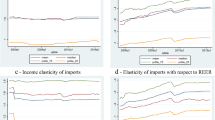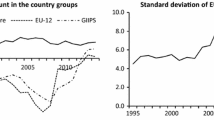Abstract
The aim of this paper is to study the main macroeconomic, financial and structural characteristics that affected current account developments in the member-states of the euro area over the period 1980–2008. The model is based on the intertemporal consumption smoothing approach according to which current account positions are determined by saving and investment decisions. The analysis uses a panel of countries that consists of the initial 12 member states of the euro area and then it expands to 17 countries aiming to see whether the enlargement or potential enlargement would in any way alter the current account determinants. All the determinants of saving and investment decisions, which include factors such as the level of development, demographics, macroeconomic policies and competitiveness, appear to be important in underpinning sustained current account positions in the euro area countries.


Similar content being viewed by others
Notes
Slovenia and Slovakia are excluded from our empirical analysis since a considerable part of the sample extends over a time period during which these countries were still under central planning and not market economies.
See, also Brissimis et al. (2009).
According to the life-cycle hypothesis the young and the old are net consumers, while the working individuals are net savers. See also Brissimis et al. (2009).
For a more complete discussion see a recent paper by Afonso and Rault (2008). The authors used panel cointegration tests to ascertain the effect of budget balances on current account balances, and their results were mixed. See, also, Briotti (2005), Bussière et al. (2004) and Debelle and Faruqee (1996).
Pooling time series has resulted in a substantial trade-off in terms of the permissible heterogeneity of the individual time series. Testing for co-integration among the variables should permit for as much heterogeneity as possible among the individual countries of the panel. If pooled results rely on homogeneous panel, then common slope coefficients are imposed. Pesaran and Smith (1995) show that if a common estimator is used when there are differences among the individual countries then the variables are not co-integrated.
The results for the unit root tests for country specific data are available upon request.
The evidence of the existence of Ricardian equivalence in the long-run equation for Belgium, Austria, Germany, The Netherlands and Spain seems to be in line with the relatively high savings ratios recorded in those countries since the introduction of the euro, but seems at odds in the case of Portugal, where significant decrease in the national saving ratio has been observed since 1999. This finding might suggest a shift of the private sector in Portugal towards a more Keynesian behaviour after 1999.
Schmitz and von Hagen (2009) find that the elasticity with respect to per-capita incomes of net capital flows between euro-area countries has increased, while this is not the case between the euro area and non euro-area countries or the rest of the world. This evidence suggests increased financial integration in the euro area.
References
Afonso A, Rault C (2008) Budgetary and external imbalances relationship: a panel data diagnostic. ECB working paper no. 961. European Central Bank
Ahearne AG, Griever WL, Warnock FE (2004) Information costs and home bias: an analysis of US holdings of foreign equities. J Int Econ Elsevier 62(2):313–336
Briotti MG (2005) Economic reactions to public finance consolidation: a survey of the literature. ECB occasional paper no. 38. European Central Bank
Brissimis SN, Hondroyiannis G, Papazoglou C, Tsaveas TN, Vasardani AM (2009) Current account determinants and external sustainability in periods of structural change. Bank of Greece, Unpublished manuscript
Bussière M, Fratzscher M, Müller GJ (2004) Current account dynamics in OECD and EU acceding countries—an intertemporal approach. ECB working paper no. 311. European Central Bank
Chinn MD, Prasad ES (2003) Medium-term determinants of current accounts in industrial and developing countries: an empirical exploration. J Int Econ 59:47–76
Chinn MD, Wei SJ (2008) A faith-based initiative: do we really know that a flexible exchange regime facilitates current account adjustment? NBER working paper no. 14420
Debelle G, Faruqee E (1996) What determines the current account? A cross-sectional and panel approach. IMF working paper no. 58. International Monetary Fund
Decressin J, Sravrev H (2009) Current accounts in a currency union. IMF working paper no. 127. International Monetary Fund
Feldstein M, Horioka C (1980) Domestic saving and international capital flows. Econ J 90:314–329
Friedman M (1953) Essays in positive economics. University of Chicago Press, Chicago
Ghosh A, Goretti M, Joshi B, Ramakrishnan U, Thomas A, Zalduendo J (2008) Capital inflows and balance of payments pressures-tailoring policy responses in emerging market economies, IMF Policy Discussion Paper, PDP/08/2
Gruber WJoseph, Kamin SB (2007) Explaining the global pattern of current account imbalances. J Int Money Finance 26:500–522
Hadri K (2000) Testing for stationarity in heterogeneous panel data. Econ J 3:148–161
Im KSM, Pesaran H, Shin Y (2003) Testing for unit roots in heterogeneous panels. J Econ 115:53–74
Kao C (1999) Spurious regression and residual based tests for cointegration in panel data. J Econ 90:1–44
Kim S, Roubini N (2008) Twin deficit or twin divergence? Fiscal policy, current account, and real exchange rate in the US. J Int Econ 74:362–383
Lane P (2006) Global bond portfolios and EMU. Int J Central Bank 2:1–23
Lane P (2008) EMU and financial market integration. Towards the first decade of economics and monetary union: experiences and perspectives, 36th economic conference 2008, Oesterreichische Nationalbank, pp 90–95
Lane P, Milesi-Ferretti GM (2008) The drivers of financial globalization. Am Econ Rev (Paper and Proceedings, x)
Pedroni P (1999) Critical values for cointegration tests in heterogeneous panels with multiple regressors. Oxford Bull Econ Stat 61:653–670
Pedroni P (2000) Fully modified OLS for heterogeneous cointegration panel. In Nonstationary panels, panel cointegration and dynamic panels. Adv Econ 15:93–130
Pedroni P (2001) Purchasing power parity tests in cointegrated panels. Rev Econ Stat 83:727–731
Pedroni P (2004) Panel cointegration: asymptotic and finite sample properties of pooled time series tests with an application to the PPP hypothesis. Econ Theory 20:597–625
Pesaran MH, Smith R (1995) Estimating long-run relationships from dynamic heterogeneous panels. J Econ 68:79–113
Schmitz B, von Hagen J (2009) Current account imbalances and financial integration in the euro area, CEPR discussion paper no. 7262
Author information
Authors and Affiliations
Corresponding author
Additional information
The views expressed in this paper do not necessarily reflect those of the Bank of Greece or the Eurosystem.
Appendix
Rights and permissions
About this article
Cite this article
Brissimis, S.N., Hondroyiannis, G., Papazoglou, C. et al. The determinants of current account imbalances in the euro area: a panel estimation approach. Econ Change Restruct 46, 299–319 (2013). https://doi.org/10.1007/s10644-012-9129-0
Received:
Accepted:
Published:
Issue Date:
DOI: https://doi.org/10.1007/s10644-012-9129-0




